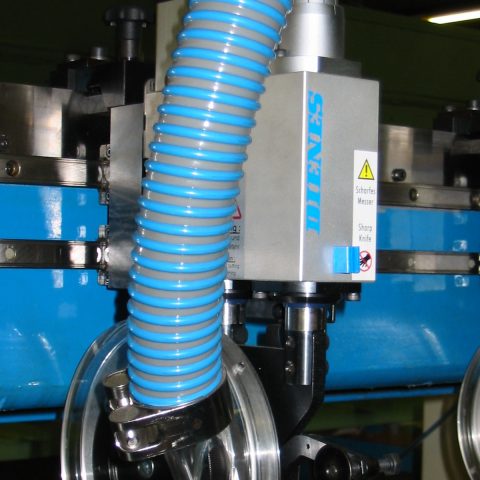Additional option: Dust suction hood

Dust generation
Low-dust cutting has always been in the focus of DIENES engineers and their research and development. DIENES innovations and patents have strongly contributed to the solution of this problem. One exapmple is the development of the additional option dust suction hood. The stability of the winder/ slitting station, the material web guiding and support, as well as the knife holder design and adjustment play a decisive role in minimizing dust accumulation. But also the material combination of the knives has an influence on the dust generation.
Despite all this, even if these factors are taken into account, the formation of dust can only be reduced not eliminated. In order to minimize disadvantages in production caused by dust, there is the possibility of dust extraction. The following parameters should be taken into account:
- Place the suction device as close as possible to the cut
- Flow velocity of the extraction system must be adapted to the machine speed and the type of dust
- If the suction power is too low, only part of the cutting dust is removed
- If the suction power is too high, there is a risk that the material web will be lifted by the bottom knife
- Without additional measures, electrostatically charged particles adhere to the material web surface
- With suction brushes, the dust collects between the bristles and can eventually fall as lumps onto the material web. In many cases, this leads to rejects.
- Encapsulated hand protection must be geometrically adapted to the specified physical influencing variables
- Dust should not accumulate in the suction nozzles
Using the additional option dust suction hood
Decisive for the effectiveness of the dust removal are the particle size, as well as the consistency of the dusts, whether they are rather dry or rather moist.
A basic distinction is made between suction from a base or suction of particles already in the air. Both types occur during the cutting process, whereby the suction of particles such as dust, fluff or fibers from a base, i.n this case the material web, requires higher negative pressures and an additional electrostatic discharge across the entire width of the material web.
The amount of dust generated during the cutting process is basically predetermined by the respective material to be cut, its thickness, the number of layers, and the chemical and physical properties. It should be borne in mind that there is no such thing as a dust-free cutting. For this reason, it is common practice to reduce the generated dust while cutting with the aid of the additional dust suction hood.
Have a look
Dust suction hood
Each shear cut knife holder has its own suction stub with nozzle. A flexible hose is attached to the nozzle to remove the cutting dust by generating a vacuum at the cutting point. Retrofitting suctions stubs to DIENES shear cut knife holders is possible.
A large part of the cutting edge dust is taken up by the suction unit. The suction stubs are installed behind the cutting knives (see web path). Suction units can be moved with the knife or easily relocated by means of a quick-release fastener. The vacuum power can be regulated at each knife.
Once the dust is in the system, it is sucked by the vacuum into the portable or permanently installed dust collection unit. This depends on the number of cutting blades. The dust falls into the chamber of the dust collection unit while the intake air is filtered and returned to the room.
Your advantages
- Cutting dust no longer falls onto the fabric webs
- Reduction of downtimes due to dust-related cleaning work
- Reduction of maintenance and repair costs